Planctoteuthis levimana
Richard E. Young, Michael Vecchione, Uwe Piatkowski, and Clyde F. E. RoperIntroduction
Planctoteuthis levimana was originally described as Mastigoteuthis levimana, based on two specimens, one of which was in fragments. It was placed in the synonomy of Planctoteuthis by Young, 1991. The genus Planctoteuthis was not recognized until 1912 (Pfeffer, 1912) and P. levimana is now the oldest species assigned to this genus. This description is based on two specimens, one of which is badly damaged but has a single tentacle with an intact club (see Young, et al., 2006). The other is in exceptionally good condition although arm tips and tentacular clubs are missing.
Brief diagnosis
A Planctoteuthis ...
- with long, slender tentacular club, without keel.
- with double but unequal knobs compose antitragus in funnel locking-apparatus.
Characteristics
- Arms
- Arms suckers on arms IV in "single" broadly spaced series of 6-8 suckers (7 suckers on the neotype and 6-8 in the type series).
- Tentacles
- Club long and slender.
- Club without aboral keel.
- Club without terminal pad.
- Funnel
- Funnel locking-apparatus oval with bilobed antitragus; lateral lobe broader; low channel between lobes off center toward medial edge of cartilage.

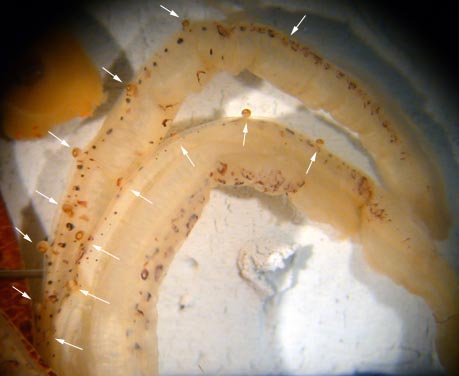
Figure. Side view of arms IV of P. levimana, neotype. Arrows point to the suckers. Sucker no. 7 in the top arm has lost its ring and is not visible in the photograph; the arrow points to its position. Note that the distal suckers are not minute. Photograph by R. Young.



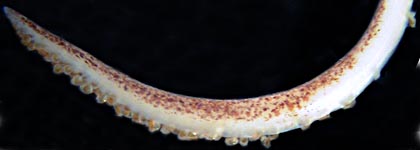
Figure. Tentacular club of P. levimana, 70 mm ML. Top - Oral view (composit photograph), preserved. Note the five (one of these represented by slight remains) large suckers in a staggered single series at the proximal end of the club. Middle - Oral view of same club before fixation. Bottom - Side view of the same club, preserved. No trace of a keel exists. Photographs by R. Young.

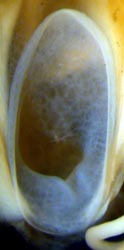
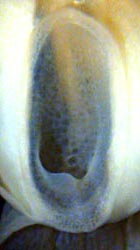
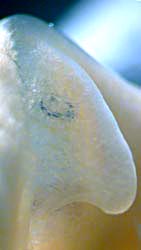
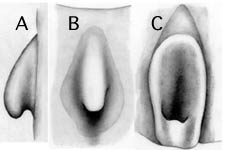
Figure. Funnel/mantle locking-apparatus of P. levimana. Left photographs - Frontal view of funnel component of specimen no. 1, 60 mm ML; Frontal view of funnel component of specimen no. 2, 70 mm ML; side view of mantle component of specimen no. 1, 60 mm ML. Photographs by R. Young. Right drawings - Drawings of locking apparatus of P. levimana, holotype; side view of mantle component; frontal view of mantle component; frontal view of funnel component. Drawings by J. Schroeder, found on file at NMNH.
Comments
More details of the description can be seen here.
Specimens for the above description came from the region of the type locality of P. levimana. The similarity of the antitragus with that illustrated of the holotype confirms the identification. The holotype of P. levimana lacked tentacles. These specimens share a double, but somewhat different, antitragus with P. danae. The latter, however, has a much larger fin than P. levimana.
Nomenclature
Young et al. (2006) found that the original type series (two specimens, one in fragments) is missing from the Zoological Museum, Uppsala University, Sweden, and designated one of the specimens they examined (the 60 mm ML immature female) as the neotype.
Life history
Nesis (1982-87) suggested that P. lippula Chun, 1908 may be the paralarva of P. levimana. The latter, however, is now known to have slender club lacking a keel which is similar to P. exopthalmica. A paralectotype of P. exopthalmica was taken by Chun in the North Atlantic (31° 59'N, 15° 5'W) and probably belongs to P. levimana. Whether or not P. exopthalmica, which is now based on a single small (9.5 mm ML) paralarva from the Indian Ocean is a junior synonym of P. levimana remains to be determined.
Figure. Ventral view of a paralarva of P. levimana, 25 mm ML, North Atlantic. Drawing from Chun (1910) identified as P. exopthalmica.
Distribution
Type locality: The holotype was taken from the north Atlantic Ocean at 43° N., 24° W; the neotype was taken nearby on July 1, 2004 at 41°31'N, 29°55'W north of the Azores in a trawl that fished from 800-1800 m. Unless the lost holotype is found, the location of the neotype is the type locality. The second specimen described here (with tentacular club) was taken on July 1, 2004 at 41°18'N, 28°15'W in a trawl that fished from 0-2400 m.
References
Chun, C. 1908. Ueber Cephalopoden der Deutschen Tiefsee-Expedition, Zoologischer Anzeiger, 33: 86-89.
Lonnberg, E. 1896. Notes on some rare cephalopods. Ofversigt af Kougl. Vetenskops-Akademiens Forhandlingar, 53: 603-612.
Nesis, K. N. 1982/87. Abridged key to the cephalopod mollusks of the world's ocean. 385,ii pp. Light and Food Industry Publishing House, Moscow. (In Russian.). Translated into English by B. S. Levitov, ed. by L. A. Burgess (1987), Cephalopods of the world. T. F. H. Publications, Neptune City, NJ, 351pp.
Young, R. E. (1972). The systematics and areal distribution of pelagic cephalopods from the seas off Southern California. Smithson. Contr. Zool., 97: 1-159.
Young, R. E., M. Vecchione, U. Piatkowski and C. F. E. Roper. 2006. A redescription of Planctoteuthis levimana (Lönnberg, 1896) (Mollusca; Cephalopoda), with a brief review of the genus. 2006. Proc. Biol. Soc. Wash. 119(4): 586-591.
Title Illustrations

| Scientific Name | Planctoteuthis levimana |
|---|---|
| Location | 41°31'N, 29°55'W |
| Specimen Condition | Fresh |
| Sex | Female |
| View | Ventral |
| Size | 60 mm ML |
| Collection | Bergen Museum, cat. no. ZMBN 77635 |
| Type | Neotype |
| Image Use |
 This media file is licensed under the Creative Commons Attribution-NonCommercial License - Version 3.0. This media file is licensed under the Creative Commons Attribution-NonCommercial License - Version 3.0.
|
| Copyright |
©

|
About This Page

University of Hawaii, Honolulu, HI, USA

National Museum of Natural History, Washington, D. C. , USA
Uwe Piatkowski

Leibniz-Institut für Meereswissenschaften

Smithsonian Institution, Washington, D. C., USA
Page copyright © 2014 , , Uwe Piatkowski, and
 Page: Tree of Life
Planctoteuthis levimana .
Authored by
Richard E. Young, Michael Vecchione, Uwe Piatkowski, and Clyde F. E. Roper.
The TEXT of this page is licensed under the
Creative Commons Attribution-NonCommercial License - Version 3.0. Note that images and other media
featured on this page are each governed by their own license, and they may or may not be available
for reuse. Click on an image or a media link to access the media data window, which provides the
relevant licensing information. For the general terms and conditions of ToL material reuse and
redistribution, please see the Tree of Life Copyright
Policies.
Page: Tree of Life
Planctoteuthis levimana .
Authored by
Richard E. Young, Michael Vecchione, Uwe Piatkowski, and Clyde F. E. Roper.
The TEXT of this page is licensed under the
Creative Commons Attribution-NonCommercial License - Version 3.0. Note that images and other media
featured on this page are each governed by their own license, and they may or may not be available
for reuse. Click on an image or a media link to access the media data window, which provides the
relevant licensing information. For the general terms and conditions of ToL material reuse and
redistribution, please see the Tree of Life Copyright
Policies.
Citing this page:
Young, Richard E., Michael Vecchione, Uwe Piatkowski, and Clyde F. E. Roper. 1999. Planctoteuthis levimana . Version 01 January 1999 (under construction). http://tolweb.org/Planctoteuthis_levimana/19494/1999.01.01 in The Tree of Life Web Project, http://tolweb.org/




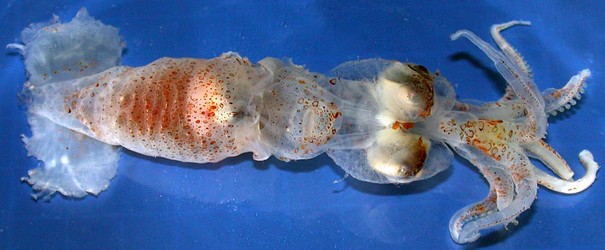

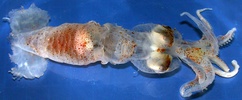


 Go to quick links
Go to quick search
Go to navigation for this section of the ToL site
Go to detailed links for the ToL site
Go to quick links
Go to quick search
Go to navigation for this section of the ToL site
Go to detailed links for the ToL site